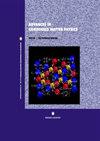The Effect of Pressure Variations on the Electronic Structure, Phonon, and Superconducting Properties of Yttrium Hydrogen Selenide Compound
IF 1.8
4区 物理与天体物理
Q3 PHYSICS, CONDENSED MATTER
引用次数: 0
Abstract
The electronic, phonon, and superconducting properties of hexagonal yttrium hydrogen selenide (YHSe) are studied using density functional theory (DFT) methods. The DFT analysis revealed that the energy bandgap and density of states near the Fermi energy (ɛF) decrease with increasing pressure. Additionally, the influence of pressure on the vibrational properties of YHSe is also examined. The findings of the vibrational properties indicate a stiffening of lattice dynamics under pressure and the identification of negative Gruneisen parameters at certain high symmetry sites. This enhances and deepens the understanding of the vibrational characteristics of YHSe under extreme pressure conditions. Finally, the electron–phonon coupling (EPC) parameter (λ) is examined under different pressures. The examination of EPCs across varying pressures showed a significant increase from 0.826 (0 GPa) to 2.6287 (200 GPa), where an increase in this EPC is found to increase the superconducting critical temperature (Tc). Furthermore, the nonmonotonic relationship between the superconducting critical temperature (Tc) and external pressure (P) in the YHSe compound is observed. Initially, Tc decreases with increasing pressure and then begins to rise again, reaching its peak value at extreme pressure. These findings provide valuable insights into the pressure-dependent properties of YHSe and have important implications for the field of superconductivity in condensed matter physics.压力变化对硒化钇氢化合物的电子结构、声子和超导特性的影响
利用密度泛函理论(DFT)方法研究了六方硒化钇(YHSe)的电子、声子和超导特性。DFT 分析表明,费米能(ɛF)附近的能带隙和状态密度随着压力的增加而减小。此外,还研究了压力对 YHSe 振动特性的影响。振动特性的研究结果表明,在压力作用下,晶格动力学变得更加坚硬,并在某些高对称性位点发现了负的格鲁尼森参数。这增强并加深了对极压条件下 YHSe 振动特性的理解。最后,研究了不同压力下的电子-声子耦合(EPC)参数(λ)。对不同压力下的 EPC 的研究表明,EPC 从 0.826(0 GPa)显著增加到 2.6287(200 GPa),EPC 的增加会提高超导临界温度 (Tc)。此外,还观察到 YHSe 化合物的超导临界温度 (Tc) 与外部压力 (P) 之间的非单调关系。起初,Tc 会随着压力的增加而降低,然后开始回升,并在极压下达到峰值。这些发现为了解 YHSe 随压力变化的特性提供了宝贵的见解,对凝聚态物理中的超导领域具有重要意义。
本文章由计算机程序翻译,如有差异,请以英文原文为准。
求助全文
约1分钟内获得全文
求助全文
来源期刊

Advances in Condensed Matter Physics
PHYSICS, CONDENSED MATTER-
CiteScore
2.30
自引率
0.00%
发文量
33
审稿时长
6-12 weeks
期刊介绍:
Advances in Condensed Matter Physics publishes articles on the experimental and theoretical study of the physics of materials in solid, liquid, amorphous, and exotic states. Papers consider the quantum, classical, and statistical mechanics of materials; their structure, dynamics, and phase transitions; and their magnetic, electronic, thermal, and optical properties.
Submission of original research, and focused review articles, is welcomed from researchers from across the entire condensed matter physics community.
 求助内容:
求助内容: 应助结果提醒方式:
应助结果提醒方式:


